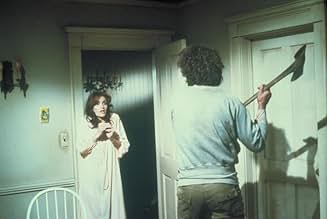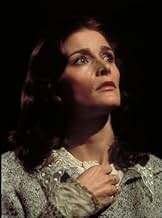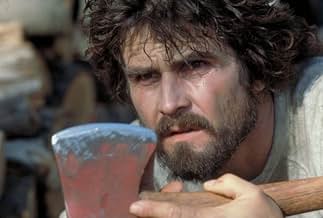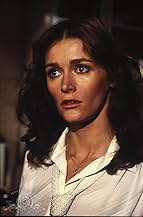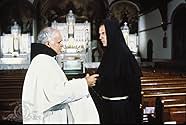Una coppia di sposi si trasferisce in una casa in cui ha avuto luogo un omicidio di massa, e viene tormentata da una serie di manifestazioni soprannaturali.Una coppia di sposi si trasferisce in una casa in cui ha avuto luogo un omicidio di massa, e viene tormentata da una serie di manifestazioni soprannaturali.Una coppia di sposi si trasferisce in una casa in cui ha avuto luogo un omicidio di massa, e viene tormentata da una serie di manifestazioni soprannaturali.
- Candidato a 1 Oscar
- 8 candidature totali
Trama
Lo sapevi?
- QuizJames Brolin's brother Brian Bruderlin was actually used for the image of the bearded man seen appearing from the 'red room' in the cellar (who is supposed to be Ronald DeFeo). The studio wanted someone who bore a close resemblance to Brolin and discovered he had a brother who shared a strong resemblance to the star. Brolin's brother was fitted with a fake beard for the part.
- Blooper(at around 1h 50 mins) Lightning smashes through one of the attic windows (during the axe attack), but subsequent exterior shots (the escape) show both windows still intact.
- Citazioni
The House: GET OUT!
- Curiosità sui creditiThis motion picture is based on the book "The Amityville Horror." Certain characters and events have been changed to heighten dramatic effect.
- Versioni alternativeMost standard cable and commercial TV broadcasts show a very edited version of the movie with commercials to fit into a two hour time slot.
Recensione in evidenza
George (James Brolin) and Kathleen Lutz (Margot Kidder) buy a "dream house" in Amityville, New York for a "dream price". Unfortunately, the price was low because just a year before, the house was the location of the Ronald DeFeo Jr. murders--he killed his entire family while they were sleeping. As a priest, Father Delaney (Rod Steiger), blesses the home, he realizes with horror that something evil is lingering there. The dream house is turning into a nightmare.
Sometimes our affection for or aversion to an artwork that we've been exposed to a number of times over the years is inextricably enmeshed with our historical, emotional experiences, whether we admit this or not. For example, I strongly dislike soap operas, or indeed any dramas that resemble soap operas. This is probably due to the fact that for years my only exposure to soap operas was when I was home sick from school as a kid. These were the days before cable television and home video. In the middle of a weekday afternoon, you either watched soap operas or you didn't watch television. Subconsciously, I associate soap operas with a feeling of illness.
Likewise, Jay Anson's Amityville Horror novel appeared when I was still a teen. I loved it. I can still remember reading it in one long sitting--something I rarely did--in the family car as we drove from Florida to Ohio to visit relatives. I was excited when the film appeared, and liked it a lot at the time.
So although I can see many faults with Amityville Horror now, I still have a deep affection for it that triggers my brain to go into an apologetic mode and defend the film. I just can't bring myself to give it lower than an 8 out of 10, and even that seems low to me. But I can easily see how audiences lacking a history with the film might dislike it. It is relatively slow, uneventful and meandering--with a modern perspective, the pacing and "subtlety" are reminiscent of some recent Asian horror. At the same time, maybe paradoxically, scenery chewing has only rarely had a greater ally.
Just a couple days ago MGM released newly remastered widescreen versions of Amityville 1, 2 and 3. I haven't seen the film look this good since seeing it in the theater in 1979, and it probably didn't even look this good then. The first thing that struck me was how incredible much of the cinematography is. Director Stuart Rosenberg had an amazing knack for finding intriguing angles for shots and imbuing them with beautiful colors.
Unlike recent trends, Rosenberg's colors are not narrowed down to a single scheme. For example, in some shots, such as some of the interiors of the famed Amityville house, we get fabulous combinations of pale greens and yellows. In others, such as many exterior shots near the house, we get intense combinations of fall foliage colors. There are also a number of beautiful shots of the famed "eye window" exterior of the house in differently tinted "negative" colors.
Rosenberg evidences a great eye for placing his cast in the frame and shooting scenes to create depth and symbolism via objects that partially block or surround the frame. He also has a knack for creating winding, receding patterns of objects that enhance depth through perspective. My affection for this aspect of the film has little nostalgic attachment, as I didn't pay attention to such things as a kid (I didn't start noticing them more until I started painting, far into my adult years), and the positive aspects of the cinematography were hardly discernible on the previous, ridiculously bad pan & scan VHS release.
Of course, most people aren't watching a film like this for the aesthetics of the visual composition. This is one of the most famous haunted house films, after all. The horror is handled somewhat awkwardly, occasionally absurdly, but it still works well enough for me, as understated as it is (I'm not referring to the acting, just the horror "objects"). Aspects such as the ubiquitous flies reminded me of similar motifs, such as water, in Hideo Nakata's horror films (such as Ringu, 1998 and Dark Water, 2002). The beginning of the film, showing the Defeo murders, still has a lot of shock value, despite its relative post-Tarantino tameness. Most of the horror elements are more portentous, but they're regular and interesting enough to hold your attention, as long as you don't mind subtlety.
Subtlety, however, was the furthest thing from the cast's minds. Brolin, Kidder and especially Steiger shout their lines more often than they speak them. "Overacting" is not in their vocabularies. Kidder comments on an accompanying documentary that the horror genre walks a fine line between intensity and camp. That may or may not be true in general, but in Amityville Horror, camp is frequently broached. For me, it has a certain charm. I'm a fan of camp and "so bad it's good"; Amityville's performances often attain both.
The commentary on the new DVD is amusing given the 1970s publicity that the book and film depicted a true haunting and the subsequent, thorough debunking by persons such as Stephen Kaplan. Hans Holzer, a parapsychologist who has been involved with the story since the early days, and the author of a book upon which Amityville II was based, provides the commentary. He presents himself as an academic, but he obviously seems to have little concern for "objectivity" or skepticism. He not only still talks about the story as true, he invents supernatural excuses for the DeFeo murders and then some, barely mentioning detractors such as Kaplan.
If you haven't seen the film yet, you should base your viewing decision on whether you have a taste for deliberately paced horror as well as a tolerance for extremely over-the-top performances. The film is historically important in the genre, as well.
Sometimes our affection for or aversion to an artwork that we've been exposed to a number of times over the years is inextricably enmeshed with our historical, emotional experiences, whether we admit this or not. For example, I strongly dislike soap operas, or indeed any dramas that resemble soap operas. This is probably due to the fact that for years my only exposure to soap operas was when I was home sick from school as a kid. These were the days before cable television and home video. In the middle of a weekday afternoon, you either watched soap operas or you didn't watch television. Subconsciously, I associate soap operas with a feeling of illness.
Likewise, Jay Anson's Amityville Horror novel appeared when I was still a teen. I loved it. I can still remember reading it in one long sitting--something I rarely did--in the family car as we drove from Florida to Ohio to visit relatives. I was excited when the film appeared, and liked it a lot at the time.
So although I can see many faults with Amityville Horror now, I still have a deep affection for it that triggers my brain to go into an apologetic mode and defend the film. I just can't bring myself to give it lower than an 8 out of 10, and even that seems low to me. But I can easily see how audiences lacking a history with the film might dislike it. It is relatively slow, uneventful and meandering--with a modern perspective, the pacing and "subtlety" are reminiscent of some recent Asian horror. At the same time, maybe paradoxically, scenery chewing has only rarely had a greater ally.
Just a couple days ago MGM released newly remastered widescreen versions of Amityville 1, 2 and 3. I haven't seen the film look this good since seeing it in the theater in 1979, and it probably didn't even look this good then. The first thing that struck me was how incredible much of the cinematography is. Director Stuart Rosenberg had an amazing knack for finding intriguing angles for shots and imbuing them with beautiful colors.
Unlike recent trends, Rosenberg's colors are not narrowed down to a single scheme. For example, in some shots, such as some of the interiors of the famed Amityville house, we get fabulous combinations of pale greens and yellows. In others, such as many exterior shots near the house, we get intense combinations of fall foliage colors. There are also a number of beautiful shots of the famed "eye window" exterior of the house in differently tinted "negative" colors.
Rosenberg evidences a great eye for placing his cast in the frame and shooting scenes to create depth and symbolism via objects that partially block or surround the frame. He also has a knack for creating winding, receding patterns of objects that enhance depth through perspective. My affection for this aspect of the film has little nostalgic attachment, as I didn't pay attention to such things as a kid (I didn't start noticing them more until I started painting, far into my adult years), and the positive aspects of the cinematography were hardly discernible on the previous, ridiculously bad pan & scan VHS release.
Of course, most people aren't watching a film like this for the aesthetics of the visual composition. This is one of the most famous haunted house films, after all. The horror is handled somewhat awkwardly, occasionally absurdly, but it still works well enough for me, as understated as it is (I'm not referring to the acting, just the horror "objects"). Aspects such as the ubiquitous flies reminded me of similar motifs, such as water, in Hideo Nakata's horror films (such as Ringu, 1998 and Dark Water, 2002). The beginning of the film, showing the Defeo murders, still has a lot of shock value, despite its relative post-Tarantino tameness. Most of the horror elements are more portentous, but they're regular and interesting enough to hold your attention, as long as you don't mind subtlety.
Subtlety, however, was the furthest thing from the cast's minds. Brolin, Kidder and especially Steiger shout their lines more often than they speak them. "Overacting" is not in their vocabularies. Kidder comments on an accompanying documentary that the horror genre walks a fine line between intensity and camp. That may or may not be true in general, but in Amityville Horror, camp is frequently broached. For me, it has a certain charm. I'm a fan of camp and "so bad it's good"; Amityville's performances often attain both.
The commentary on the new DVD is amusing given the 1970s publicity that the book and film depicted a true haunting and the subsequent, thorough debunking by persons such as Stephen Kaplan. Hans Holzer, a parapsychologist who has been involved with the story since the early days, and the author of a book upon which Amityville II was based, provides the commentary. He presents himself as an academic, but he obviously seems to have little concern for "objectivity" or skepticism. He not only still talks about the story as true, he invents supernatural excuses for the DeFeo murders and then some, barely mentioning detractors such as Kaplan.
If you haven't seen the film yet, you should base your viewing decision on whether you have a taste for deliberately paced horror as well as a tolerance for extremely over-the-top performances. The film is historically important in the genre, as well.
- BrandtSponseller
- 6 apr 2005
- Permalink
I più visti
Accedi per valutare e creare un elenco di titoli salvati per ottenere consigli personalizzati
- How long is The Amityville Horror?Powered by Alexa
Dettagli
- Data di uscita
- Paese di origine
- Lingua
- Celebre anche come
- El horror de Amityville
- Luoghi delle riprese
- 18 Brooks Road, Toms River, New Jersey, Stati Uniti(Amityville house)
- Aziende produttrici
- Vedi altri crediti dell’azienda su IMDbPro
Botteghino
- Budget
- 4.700.000 USD (previsto)
- Lordo Stati Uniti e Canada
- 86.432.000 USD
- Fine settimana di apertura Stati Uniti e Canada
- 7.843.467 USD
- 29 lug 1979
- Lordo in tutto il mondo
- 86.432.000 USD
- Tempo di esecuzione1 ora 57 minuti
- Colore
- Mix di suoni
- Proporzioni
- 1.85 : 1
Contribuisci a questa pagina
Suggerisci una modifica o aggiungi i contenuti mancanti



